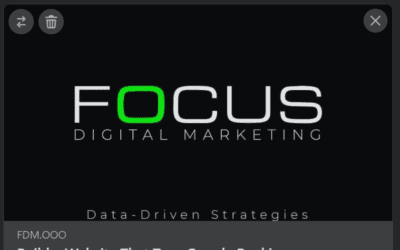This idea really started more than 20 years ago, with a story. I’ll do my best to keep it brief.
Back in 2001 my buddy and I had an idea for an automotive-related business, nothing related to websites or marketing at all. We spent $6,000 with a company to develop a website for us to sell our product, a few months went by and the company ceased to exist and they had taken our money. We didn’t have money to do that again so the only way to move forward was to learn how to code and build the website myself from scratch.
Back in those days, customizing MySpace pages with HTML code was all the rage, so I had learned a bit of code by playing with Myspace this wasn’t going to be enough to build a complete website so I dove in and absorbed everything I could and by the beginning of 2002, I could write an entire website code on a napkin, which actually did happen one night at a Wild Wings while trying to describe an idea. The first websites were simple, but they worked, however, the business was a flop, so by the end of 2003 I was building websites for friends and family. As time progressed and relationships grew I would have clients call and ask me “hey can you do…” and my answer was always yes, sometimes that meant a crash course learning something, sometimes it meant buying a $20,000 piece of equipment but I always said yes. Over the years we essentially became a one-stop shop for everything marketing, under one roof.
As time went on, I began to realize that a website’s appearance wasn’t everything. The iceberg analogy was born which is still used to this day by many agencies – just as an iceberg has a small visible portion above the waterline and a much larger portion hidden beneath the surface, so too does a website. The parts of the website that you can’t see are the most important.
There were tools available to scan a website’s code and assess its compliance with accepted standards, as well as tools to check its SEO value and domain authority. But these tools were expensive and often inaccurate. The data they provided was only a rough approximation of a website’s standing, rather than a precise assessment. We realized that there had to be a better way, and so began the journey toward creating the FOCUS Engine AI.
After ten years of hard work and growing from one guy with an idea to a team of fantastic people, we finally have a tool that we are proud of. So in the fall of 2022, we began to secretly test it on our client’s websites, and we began implementing changes based on the data and it was immediately apparent how powerful this thing was.
So What Does It Do?
The FOCUS Engine AI is designed to scan a website and gather data. It then compares this data to competitor websites that are ranked above and below, analyzing what sets them apart. By looking at websites that consistently rank in the top three in every city in the US and comparing them to sites that rank outside of the top 10, it then makes associations with what causes one to rank lower versus the ones that rank higher. You may not know this but the google algorithm changes all the time, and you simply can’t crack it, BUT if you can look at sites that rank in the top 3 in every city in the US and compare those to sites that rank outside of the top 10 you can determine what google actually wants and when you know that you can satisfy the google algorithm. Armed with this knowledge, we can satisfy the Google algorithm and help our client’s websites rank higher in search engine results.
But the FOCUS Engine AI doesn’t stop there. We also look at how people search for things in different areas of the world. Language, dialect, and local slang all play a role in how people search for things online. A person in NYC might search for “hood repair,” while someone in England might search for “bonnet repair.” By adjusting a website’s keywords and language to reflect these differences, we can improve its chances of appearing higher in search engine results.
Finally, we analyze how website visitors engage with a website. What content do they skip over? What makes them pause to read? What images catch their attention? What prompts them to click the “call now” button? By piecing together all of this information, we can create websites that are both simple and effective.
While some may wonder whether the FOCUS Engine AI is truly “AI,” we like to think that it fits the definition of the term. Artificial intelligence leverages computers and machines to mimic the problem-solving and decision-making capabilities of the human mind. Our system can scan every electrician website in the top three on Google and the 11-14 positions, a task that would be impossible to accomplish by a human, is completed in hours by our system. While it may not pass the Turing test, the FOCUS Engine AI is an amazing tool that has helped us provide unparalleled service to our clients.
Watched a Tech Tutorial on YouTube? You Might Be Under Surveillance! Not ClickBait!
Beware: Your YouTube Tech Interests Could Lead to Federal Scrutiny The recent subpoena of Google to unveil details of thousands of YouTube viewers watching technology-related content has sparked a privacy uproar. What seemed like innocent tutorials on drone mapping...
Maximizing Social Shares: Mastering Website OpenGraph Settings
What Are Website OpenGraph Settings? OpenGraph settings, a preview for social media interaction, comprise HTML tags that turn a simple URL share into an improved media experience. When you share a webpage on social platforms like Facebook, these tags dictate how the...







